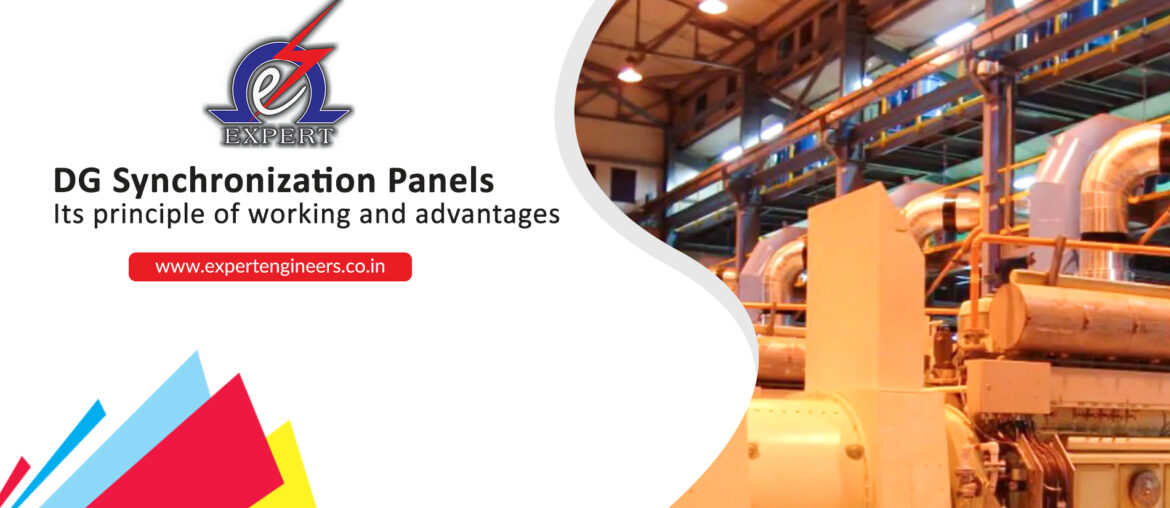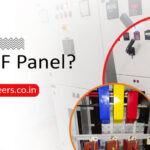Expert Engineers is a renowned DG Synchronization Panel manufacturer with a state-of-the -art manufacturing plant at Khushkhera, Bhiwadi .
We shall briefly explain through blog; What is D.G. Synchronization, what is D.G. Synchronization panel, how does it work, why is it needed? what are the procedures of D.G. Synchronization and its advantages.
Process of DG Synchronization:
Process of Diesel Generator synchronization basically constitutes matching the undermentioned parameters of an alternator (Diesel Generator) with an existing healthy running power system. It is done before connecting DG to the healthy power system.
Technical parameters which are matched during DG Synchronization are
- Voltage
- Frequency
- Phase angle
- Phase sequence
- Waveform of Diesel Generator
What is Diesel Generator synchronization panel?
Basically DG Synchronization panels are mainly designed for meeting critical aspects of Power system requirements which primarily includes uninterrupted or flashing restoration of Power supply along with DG and circuitry protection for an infrastructure of social or commercial values and repute ( like Hospitals , Malls , Multistoried residential societies, Hotels, Telecommunication sectors and Industries with varied loads of power implementation ) D.G. Synchronization panels work both manually and with an automatic synchronizing function using PLC for two or more generators or breakers. They are pre-dominantly used in electro-mechanical synchronizing of Diesel generators and provide multiplex solutions.
How does a Diesel Generator synchronization panel work?
Diesel Generator synchronization is the process of matching technical electrical parameters such as voltage, frequency, phase angle, phase sequence, and waveform of Diesel generator with a healthy or running power system. This is required to be done just before the generator is reconnected to the power system.
What is the purpose of Diesel generator synchronization?
In an alternating current electric power system, Electrical synchronization is the process of matching the speed and frequency of a Diesel generator to a running network or an existing power supply system. An AC generator needs to be essentially electrically synchronized to deliver power to an electrically grid for running at the same frequency as the network or an existing power supply system.
Why is electrical synchronization needed?
Synchronization need generates when processes need to operate concurrently The main purpose of synchronization is the sharing of electrical power resources without interference using mutual exclusion through schematics of frequent changeover , load sharing management . The other purpose is the coordination and providing protection of the process interactions and components looped there in ; in the electrical synchronization operating system.
How do generators get electrically synchronize?
Electrical synchronization of Diesel generators are done by introducing PLC based or manual control fed to the exciter current and speed for engine of the diesel generator. Diesel generator synchronization need arises when electrical loads are not constant every time and it needs to be electrically balanced.
What effect does it reflects if generators are not electrically synchronized?
Lack of synchronizing or poor synchronizing can thus damage the generator and the prime mover because of fluctuating mechanical stresses caused by rapid acceleration or deceleration of speed , bringing the rotating masses into synchronism (exactly matched speed and rotor angle) with the power system.
D.G. Set Synchronization Panels are manufactured incorporating under mentioned features
1. Load Sharing Management
By Programmable Logic Control – PLC ( Automatic )
By Programming parameters using PLC or microcontroller programmable relays made to automatically sense parameters from one or many of the following the load demand voltage , frequency , phase angle , engine speed , power factor all parameters on common bus and display acquired on SCADA (Supervisory Control and Data Acquisition).
Active Load Sharing
It is attained by increasing or decreasing rotation per minute ( rpm ) of engine with the help of potentiometer fitted in panel.
Reactive Load Sharing
It is attained by increasing or decreasing voltage of alternator with the help of potentiometer fitted in panel.
Parallel Connection of Generators enhances the total power output, optimizes control of load sharing management, reduces maintenance constraints and minimizes idleness of critical diesel generator load sharing management.
2. AMF (Auto Mains Failure)
Auto-Mains Failure (AMF) panels, usually termed to be an automatic transfer switch (ATS) electrical panels regulating the automatic power switch to already looped emergency supply generators in the event of a significant loss of mains power or mains failure from Electricity Board.
3. Protection to Generators
- Engine Protection
- Alternator Protection
- Auxiliary Control Protection
4. Differentiation as justified between paralleling and synchronization are as mentioned below :
Parallel Connection of Generators enhances the total power output , optimizes control of load sharing management , reduces maintenance constraints and minimizes idleness of critical diesel generator load sharing management .
whereas the synchronization equalizes the sinusoidal waveform of the output voltage of one generator with the voltage waveform of the other generators.
Uses of Load Sharing and DG Synchronization Panels :
Application are intended to shoulder peak saving or base load operation in heavy energy consuming industries such as oil refineries, petrochemical refineries, steel mills, mines, cement factories, food processing, Multi storied residential colonies , Hospitals , Malls, Hotels , Telecommunication sectors etc.
Advantages of Load Sharing and DG Synchronization Panels :
- DG Synchronization Automatically done
- AMF Operation
- Engine Protection
- Alternator Protection
- Auxiliary Control






